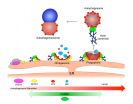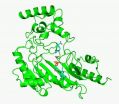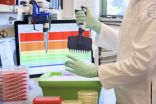Now, the same research team has teased apart the molecular basis for these differences and identified a drug treatment that at least partially restores function to diseased cells grown in a laboratory dish. They also observed how a key cardiac signaling cascade, called the beta-adrenergic pathway, develops as heart muscle cells mature, and identified key aspects about how it functions in both normal and diseased cells.
The researchers hope that the findings will help clinicians better hone treatments for a variety of cardiac conditions, which are now often treated with a one-size-fits-all approach.
'Right now, nearly all patients with cardiomyopathy are given drugs to modulate the beta-adrenergic pathway in the heart, which is known to be dysfunctional,' said Joseph Wu, M.D., Ph.D., director of Stanford's Cardiovascular Institute. 'But until now, we've not known what exactly is going wrong with this pathway at a molecular level.'
A paper describing the research will be published online June 18 in Cell Stem Cell. Wu, a professor of medicine and of radiology, is the senior author of the paper, and postdoctoral scholar Haodi Wu, Ph.D., is the lead author. (Joseph Wu and Haodi Wu are not related.)
Using skin-derived cells to study disease
The research relies on what's known as induced pluripotent stem cells, or iPS cells, to make heart muscle cells from skin. IPS cells can be coaxed to develop into nearly any tissue in the body. The technique gives researchers access to a variety of human cell types, such as brain and heart muscle cells, that are typically difficult to obtain for study.
This study adds to others suggesting that heart muscle cells made from skin cells accurately incorporate the minute details of diseases that afflict those from whom the skin cells were derived.
'We wanted to characterize the mechanisms that underlie the functional impairment of the cells,' said Haodi Wu. 'Until now, we've used iPS-cell-derived heart muscle cells as a disease model for cardiomyopathy, but it's not been known how precisely these cells recapitulate the disease phenotype. Now we see that, although diseased and healthy cells undergo a similar developmental and maturation process, the mutation carried by the diseased cells causes them to respond differently to signaling by the beta-adrenergic pathway.'
Dilated cardiomyopathy occurs when a portion of the heart muscle enlarges and begins to lose the ability to pump blood efficiently. Eventually, the enlarged muscle weakens and fails, requiring either medication or even transplant. Dilated cardiomyopathy can be due to restrictions in blood flow (a condition known as ischemia) that can cause a heart attack, or to nonischemic causes such as viral infection. Although many cases of nonischemic dilated cardiomyopathy occur sporadically and without an apparent cause, dilated cardiomyopathy can also be inherited through a variety of genetic mutations. One of these mutations affects a protein called TNNT2, which is located on the muscle fibers of the heart and helps to regulate their contraction.
The researchers were building upon a 2011 study from the Wu lab published in Science Translational Medicine showing that stem-cell-derived heart muscle cells from people with cardiomyopathy differ in obvious ways from those derived from healthy people. They contract less forcefully and respond less strongly to the beta-adrenergic signaling pathway that increases heart rate and stroke volume and force in response to stress or exercise.
Molecular messengers degraded
Haodi Wu and his colleagues showed that mutated TNNT2 in the cells from patients with dilated cardiomyopathy travels into the cells' nuclei and stimulates chemical tags like methyl groups to attach to DNA and DNA-packaging protein complexes called histones. This process is called epigenomic modification. These modifications work to increase the expression of two genes encoding proteins called phosphodiesterases, which degrade small molecular messengers essential to the beta-adrenergic signaling pathway.
To test their findings, the researchers stimulated iPS-cell-derived heart muscle cells with isoproterenol, which activates the beta-adrenergic pathway. Healthy cells responded vigorously, contracting about 80 percent more quickly and with about 60 percent more force. In contrast, the contraction rate of the diseased cells only increased by about 37 percent, and the force of the contraction remained roughly the same.
'We saw a very dramatic effect in normal cells, but a much smaller functional change in cells made from patients with dilated cardiomyopathy,' said Haodi Wu. 'This is very similar to what we see in human patients. They can have a high blood adrenaline level, but the output of their heart remains weak.'
When the researchers treated the cells with molecules that blocked the function of the phosphodiesterase proteins, diseased cells responded more strongly to isoproterenol treatment, and their contraction rate and force approached that of healthy cells.
'As a cardiologist, I feel this basic research study is very clinically relevant,' said Joseph Wu. 'The beta-adrenergic pathway is a major pharmaceutical target for many cardiac conditions. This study confirms that iPS-cell-derived cardiomyocytes can help us to understand biologically important pathways at a molecular level, and can aid in drug screening. The ability to make a patient's own heart cells for study is the epitome of personalized medicine.'
INFORMATION:
Other Stanford co-authors are postdoctoral scholars Mingxia Gu, Ph.D., Feng Lan, Ph.D., and Jared Churko, Ph.D.; cardiovascular medical fellow Karim Sallam, M.D.; instructor Elena Matsa, Ph.D.; graduate student Arun Sharma; and senior research scientist Joseph Gold, Ph.D.
The work was funded by the American Heart Association and the National Institutes of Health (grants U01HL099776, R01HL113006, R01HL123968 and R24 HL117756).
Information about Stanford's Department of Medicine and the Stanford Cardiovascular Institute, which also supported the work, is available at http://medicine.stanford.edu and http://cvi.stanford.edu.
The Stanford University School of Medicine consistently ranks among the nation's top medical schools, integrating research, medical education, patient care and community service. For more news about the school, please visit http://med.stanford.edu/school.html. The medical school is part of Stanford Medicine, which includes Stanford Health Care and Lucile Packard Children's Hospital Stanford. For information about all three, please visit http://med.stanford.edu.




